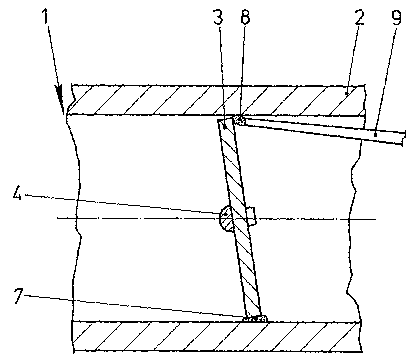Some of the information on this Web page has been provided by external sources. The Government of Canada is not responsible for the accuracy, reliability or currency of the information supplied by external sources. Users wishing to rely upon this information should consult directly with the source of the information. Content provided by external sources is not subject to official languages, privacy and accessibility requirements.
Any discrepancies in the text and image of the Claims and Abstract are due to differing posting times. Text of the Claims and Abstract are posted:
| (12) Patent Application: | (11) CA 2431931 |
|---|---|
| (54) English Title: | METHOD FOR SEALING OFF A GAP BETWEEN A THROTTLE VALVE PIVOTABLY MOUNTED IN A THROTTLE VALVE ASSEMBLY AND THROTTLE VALVE ASSEMBLY |
| (54) French Title: | PROCEDE PERMETTANT D'ETANCHEIFIER UN ESPACE SITUE ENTRE UN PAPILLON DES GAZ MONTE PIVOTANT DANS UN CARTER ET LEDIT CARTER |
| Status: | Deemed Abandoned and Beyond the Period of Reinstatement - Pending Response to Notice of Disregarded Communication |
| (51) International Patent Classification (IPC): |
|
|---|---|
| (72) Inventors : |
|
| (73) Owners : |
|
| (71) Applicants : |
|
| (74) Agent: | SMART & BIGGAR LP |
| (74) Associate agent: | |
| (45) Issued: | |
| (86) PCT Filing Date: | 2001-12-12 |
| (87) Open to Public Inspection: | 2002-06-20 |
| Availability of licence: | N/A |
| Dedicated to the Public: | N/A |
| (25) Language of filing: | English |
| Patent Cooperation Treaty (PCT): | Yes |
|---|---|
| (86) PCT Filing Number: | PCT/DE2001/004667 |
| (87) International Publication Number: | DE2001004667 |
| (85) National Entry: | 2003-06-12 |
| (30) Application Priority Data: | |||||||||
|---|---|---|---|---|---|---|---|---|---|
|
The invention relates to a throttle valve connection (1), in which a liquid
sealing mass (7, 8) is exclusively applied to an adjoining zone of a tubular
housing (2) and a throttle valve (3), using a cannula (9). The sealing mass
(7, 8) reaches the zone between the tubular housing (2) and the throttle valve
(3) by capillary force and subsequently hardens. This prevents a wetting of
the surface of the throttle valve (3) by the sealing mass (7, 8).
Procédé qui consiste à déposer une masse d'étanchéité (7, 8) liquide dans un carter (1) de papillon des gaz, à l'aide d'une canule (9), exclusivement dans une zone dans laquelle le papillon des gaz (3) est adjacent à un boîtier (2) tubulaire. La masse d'étanchéité (7, 8) parvient, sous l'effet de forces capillaires, dans la zone située entre le boîtier tubulaire (2) et le papillon des gaz (3), où ladite masse durcit. Une aspersion de masse d'étanchéité (7, 8) sur la surface du papillon des gaz (3) est ainsi évitée.
Note: Claims are shown in the official language in which they were submitted.
Note: Descriptions are shown in the official language in which they were submitted.

2024-08-01:As part of the Next Generation Patents (NGP) transition, the Canadian Patents Database (CPD) now contains a more detailed Event History, which replicates the Event Log of our new back-office solution.
Please note that "Inactive:" events refers to events no longer in use in our new back-office solution.
For a clearer understanding of the status of the application/patent presented on this page, the site Disclaimer , as well as the definitions for Patent , Event History , Maintenance Fee and Payment History should be consulted.
| Description | Date |
|---|---|
| Time Limit for Reversal Expired | 2006-12-12 |
| Application Not Reinstated by Deadline | 2006-12-12 |
| Deemed Abandoned - Failure to Respond to Maintenance Fee Notice | 2005-12-12 |
| Letter Sent | 2004-08-26 |
| Letter Sent | 2004-08-26 |
| Inactive: Correspondence - Transfer | 2004-07-26 |
| Inactive: Office letter | 2004-06-08 |
| Inactive: Single transfer | 2004-05-10 |
| Inactive: Courtesy letter - Evidence | 2003-08-12 |
| Inactive: IPRP received | 2003-08-08 |
| Inactive: Cover page published | 2003-08-07 |
| Inactive: Notice - National entry - No RFE | 2003-08-04 |
| Application Received - PCT | 2003-07-16 |
| National Entry Requirements Determined Compliant | 2003-06-12 |
| Application Published (Open to Public Inspection) | 2002-06-20 |
| Abandonment Date | Reason | Reinstatement Date |
|---|---|---|
| 2005-12-12 |
The last payment was received on 2004-11-12
Note : If the full payment has not been received on or before the date indicated, a further fee may be required which may be one of the following
Patent fees are adjusted on the 1st of January every year. The amounts above are the current amounts if received by December 31 of the current year.
Please refer to the CIPO
Patent Fees
web page to see all current fee amounts.
| Fee Type | Anniversary Year | Due Date | Paid Date |
|---|---|---|---|
| Basic national fee - standard | 2003-06-12 | ||
| MF (application, 2nd anniv.) - standard | 02 | 2003-12-12 | 2003-11-13 |
| Registration of a document | 2004-05-10 | ||
| MF (application, 3rd anniv.) - standard | 03 | 2004-12-13 | 2004-11-12 |
Note: Records showing the ownership history in alphabetical order.
| Current Owners on Record |
|---|
| SIEMENS AKTIENGESELLSCHAFT |
| Past Owners on Record |
|---|
| JORG FLIEGNER |
| PETER KOHLEN |